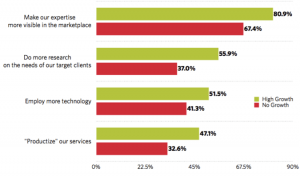With the recent release of our consulting services edition of the 2018 High Growth Study comes a new set of data on high-growth firms in the industry. Today, I want to focus on just one aspect of this study: how consulting marketing priorities for 2018 differ between high-growth firms and their no-growth peers.
Download the 2018 High Growth Study: Consulting Firm Edition
To get at this issue, I’d like to consider two important questions: 1) Is there anything different in the way these two groups view the marketplace?; and 2) How do they plan to respond to those conditions?
By the end of this exercise, I think you’ll appreciate not only how these two groups differ, but why the high-growth cohort is able to get more traction and visibility. And, I hope, you’ll have some sense of how your firm might benefit from adjusting its marketing priorities.
A Peek into the Future
A new feature of this year’s study was a set of questions designed to capture perspectives on the future of the industry. When asked to look ahead to the next three to five years, no-growth firms identified these issues as their top challenges:
- Increased competition from larger firms
- Downward price pressure
- Commoditization of services
- Shortage of top talent
High-growth firms, however, listed an entirely different set of challenges:
- Need for new skills
- Unpredictability in the marketplace
- Automation and artificial intelligence
- Globalization of the industry
When I look at the list from the no-growth segment, I notice that three of the four items (a shortage of talent being the lone exception) describe ways these firms might lose value from market forces that have been in play a long time.
Commoditization has been an ongoing challenge to many consulting practices, especially as self-serve and automated SaaS-based technologies replace skilled human beings and bring costs — and margins — down. In addition, the gradual consolidation of major and minor players makes it incrementally more difficult for small and mid-size firms to compete for a relatively steady number of potential clients.
And competing for top talent is an age-old problem. If you aren’t a market leader or a vibrant up-and-comer, it’s difficult to attract the best and the brightest.
Okay, let’s analyze the high-growth list of future challenges next. Their top concern, “need for new skills,” stood out to me right away. This is not some worrisome existential threat. Instead, it is a solution in the making. High-growth firms recognize that acquiring new skills is a key to their continued success — and they are planning to do something about it!
Market unpredictability and globalization are tricky because they are difficult to counter. There is a solution, however, but let’s set these two aside for the moment and return to them in a moment.
At first, automation and artificial intelligence sound similar to “commoditization of services” in the no-growth list. But they are much more specific. Automation and artificial intelligence are interesting because with the advent of each, firms have the opportunity to deliver services more efficiently, with potentially more meaningful and expedited results. In this sense, neither is a threat but rather an opportunity. On the other hand, both automation and AI have lowered the playing field and made it easier for newcomers to enter – and in the end, crowd the marketplace. In this lies the threat.
What’s the takeaway, here? When I compare both lists, I get the sense that no-growth firms are worried about forces that already are eating away at their businesses. They are still trying to find answers to old questions.
High-growth firms, on the other hand, are more proactive. They are looking to future for new growth opportunities. They know they need to acquire different skills over time, and they assessing the double-edged sword of transformative technologies like automation and AI.
But they also know that more competition is on the way from offshore talent pools and that the future is difficult to predict. These firms are invested in change, and they know they have to be ready to pivot as new conditions develop.
How Tomorrow’s High-Growth Firms Will Go to Market
Next, let’s take a look at a related set of data — one that describes the way high-growth and no-growth firms plan to address the challenges they see ahead.
Figure 1 below features the top ways high-growth firms plan to address their future challenges. The responses of no-growth firms are included for the sake of comparison.
Figure 1. Top Strategies High-Growth Firms Use to Address Threats to the Consulting Industry

These four strategies fall into two general categories: marketing and delivery. Interestingly, the two highest-priority strategies sit in the marketing category.
The top priority of high-growth firms is to increase the visibility of their expertise. According to the study, of the ten most impactful marketing techniques used by high-growth firms, seven demonstrate a firm’s expertise, and all but one contribute to its visibility. Half of these content-based techniques are content marketing tools, such as publishing original research and blogging. Now, remember above, when I described “market unpredictability” and “globalization” as tricky challenges? Content marketing and other visibility-enhancing strategies are really good at breaking down geographic barriers and building a firm’s reputation — even in an uncertain marketplace.
High-growth firms are also big believers in researching their target audience. More than half of them conduct formal, structured research at least once a year — and they are 82% more likely to do so than no-growth firms. This regular research gives them empirical insights into their marketplace, equipping them to detect changing conditions and adapt to them faster.
Download the 2018 High Growth Study: Consulting Firm Edition
Technology can deliver new efficiencies, deeper insights and speedier results, so it’s no wonder that high-growth firms are 25% more likely to invest in tech than their no-growth brethren.
The best-performing companies are also more likely to turn some or all of their services into easier-to-deploy, simpler-to-sell products. By offering highly automated, low-customization services, firms can increase their margins — and their client satisfaction levels.
What are the implications of this research on your business? If knowledge is power, you now know a little bit more about the consulting industry than before. Take a hard look at how you plan to allocate your limited resources in the coming year, then compare it to the priorities of high performers. Are you closer to the no-/low-growth camp? Or are in sync with the high flyers?
To get started, download the free executive guide today. Or purchase the full report for all the details.
Additional Resources:
- Turn your firm into a high-visibility, high-growth business. Download our free executive guide, The Visible Firm®, in which we lay out an in-depth roadmap of this research-based program.
- Need to train your marketing team in the latest growth strategies and marketing techniques? Want to implement Hinge’s Visible Firm® or Visible Expert® programs yourself? Then check out Hinge University. These are the same resources Hinge uses to train our own professionals!
How Hinge Can Help:
Hinge’s Visible Firm® Program is the leading marketing program for delivering greater visibility, growth, and profits. This customized, research-based program will identify the most practical offline and online marketing tools your firm will need to attract new clients and reach new heights of success.


